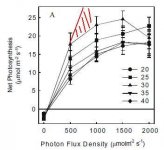S
secondtry
The other topic I would like to discuss is the average PPFD to use on a grow.
Based on same studies, secondtry and me think different. He thinks 1500 uE/m2 is optimal, as MJ continues increasing photosynthesis up to that. Indeed, MJ does well close to 30ºC up to 2000uE.
I don't suggest that high, over ~1,600 PPFD causes "photoinhibition", and lower intercellular Co2. That high irradiance (i.e., 2000 PPFD) will cause the plant to have "midday depression" and low stomatal conductance. I suggest at least 1,000 PPFD, and ideally 1,300-1,500 PPFD, but not over 1,500 PPFD according to the four studies on cannabis I was able to find.
also If a grower is looking for max production (g/m2) of a given grow area, I agree this would be the optimal, specially if there is CO2 enrichment.
Me too, up to about 1,500 PPFD.
On the opposite, me, as a grower, Im more interested on the productivity of the light (g/W). As irradiance increases over 400uE/m2 or so, light productivity starts to drops.
What do you mean by "productivity"? Do you mean by energy, i.e., 400 PPFD is a lower electric bill? If so I agree, but I for one want the biggest yield, not the best energy use efficiency; I don't mind spending an extra $50 a month on electric bill for great increased yield, Pn, WUE (Water Use Efficiency), etc.
Notice that average PPFD is a concept very different to actual PPFD. While PPFD is a measured figure only valid for the conditions and situation of the point where the measurement were performed, average PPFD is calculated by dividing the PPF by the area to be grown.
PPFD is measured by the meter^2 per second, net PPFD is the total PPFD over a day, which is called the "daily light integral" (DLI). That is why one can offer high PPFD (e.g., > 1,000 PPFD) and still keep the DLI low enough to prevent photoinhibition by using an hour of dark, or simply dimming the lamp for a bit. However, if one keep PPFD around 1,300 all day the DLI will not cause photoinhibition and the associated ills like midday depression, etc.
Here is dietoring for find the Its just a reference for configuring setups, to know how much light we need to install depending on our priorities. In general, growers looking the best light productivity uses about half light that growers looking for max production of grow area, for any type of light.
I agree, those who want to spend less on the monthly electric bill will use lower PPFD while also lowering their yield. But a grower who wants max yield and doesn’t care about the electric bill will use at least >1,000 PPFD all day for a high DLI.
For example, HPS growers looking for max light productivity uses about 40-50W/ sq ft, and growers looking for max total production uses 75-100W/ sq ft. For reference, that means than on a 10 sq ft area ( al ittle less than 1 sq meter), a grower using a 400W HPS looking for max light productivity is aiming an average PPFD of 500uE/m2, while one looking for max production uses a 600W (825uE/m2) up to a 1000W (1300 uE/m2).
I’m curious where you got hose PPFD figures, are they just examples or are the from a quantum sensor? I only ask because they look accurate and I have yet to find studies or data showing the PPFD of HID lamps over 400w.
But saying that averages irradiances of 500uE don’t yield is simply false.
I didn’t' say that, all I ever wrote was ideal Pn and yield comes from high irradiance, I always agreed lower irradiance can grow plants, but it won't grow ideal cannabis plants.
Many people uses that irradiances using HIDs. Taking into account than well designed LED lamps offer better spectral productivity (P/mol photons or g/mol photons) and distribute light way more homogeneously (PPFD measured along the grow have way lower differences that those measured on any HID grow), 500uE/m2 is an excellent average. Indeed, I know many people using 300-400uE/m2 in average with excellent results (getting over 2g/W).
I agree that "productive" (i.e., electric bill) is better with lower irradiance; and I also agree LED arrays offer a more homogenous irradiant footprint, but that footprint is small. To insure HID offers very high homogenous irradiance footprint I use a light mover; that makes HID irradiance footprint very high in terms of homogeneity; that and an HID grower needs to buy the best reflector they can. I plan to design my own reflector, which is the best way as one can design it around a specific lamp which will greatly limit "re-strike" of photons and max the PPFD and homogeneity of the irradiance footprint.
Notice than an average 500 uE/m2 may obtain PPFD in excess of 1000uE/m2 on the upper canopy below the lamp. Way higher when using single point light sources (HID), that need to keep at some distance of canopy to avoid light bleaching due excessive irradiance, that means PPFD over 2500uE/m2.
I don’t' quite understand what you are wrote above. How can 500 PPFD (umol/m^2/s) equal 1,000 PPFD? Do you mean the "incident PPFD" (aka "PPFD-I") of the "whole canopy"? If so HID with high green photons is best (like Hortilux Blue) because green photons best penetrate into the lower canopy bouncing off of leafs until they are absorbed. For example, I will use the Hortilux Blue 1000w HID with a PPFD of at least 1,000 which will offer VERY high lower canopy PPFD due to the green photons, and the PPFD-I will also be very high. You can find PPFD-I by finding the leaf angle and total leaf mass/density. Using PPFD-I is like 3-D while using PPFD is like using 2-D. Here is a great paper on this topic: http://www.plant.uoguelph.ca/courses/pbio-3110/documents/Lec11.pdf
Thanks for the good talk!



